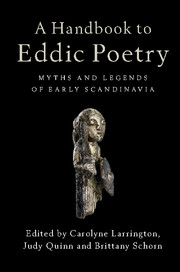Book contents
- Frontmatter
- Contents
- List of illustrations
- List of contributors
- Translations and abbreviations of the titles of eddic poems
- Introduction
- 1 The transmission and preservation of eddic poetry
- 2 Traditions of eddic scholarship
- 3 The editing of eddic poetry
- 4 The dating of eddic poetry
- 5 Eddic performance and eddic audiences
- 6 Eddic poetry and mythology
- 7 Eddic poetry and the religion of pre-Christian Scandinavia
- 8 Eddic poetry and heroic legend
- 9 Place names in eddic poetry
- 10 Eddic poetry and the imagery of stone monuments
- 11 Eddic poetry and archaeology
- 12 Eddic modes and genres
- 13 Eddic metres
- 14 Eddic style
- 15 Kennings and other forms of figurative language in eddic poetry
- 16 Alliterative lexical collocations in eddic poetry
- 17 The representation of gender in eddic poetry
- 18 The reception of eddic poetry
- Consolidated bibliography
- Index
5 - Eddic performance and eddic audiences
Published online by Cambridge University Press: 05 August 2016
- Frontmatter
- Contents
- List of illustrations
- List of contributors
- Translations and abbreviations of the titles of eddic poems
- Introduction
- 1 The transmission and preservation of eddic poetry
- 2 Traditions of eddic scholarship
- 3 The editing of eddic poetry
- 4 The dating of eddic poetry
- 5 Eddic performance and eddic audiences
- 6 Eddic poetry and mythology
- 7 Eddic poetry and the religion of pre-Christian Scandinavia
- 8 Eddic poetry and heroic legend
- 9 Place names in eddic poetry
- 10 Eddic poetry and the imagery of stone monuments
- 11 Eddic poetry and archaeology
- 12 Eddic modes and genres
- 13 Eddic metres
- 14 Eddic style
- 15 Kennings and other forms of figurative language in eddic poetry
- 16 Alliterative lexical collocations in eddic poetry
- 17 The representation of gender in eddic poetry
- 18 The reception of eddic poetry
- Consolidated bibliography
- Index
Summary
What exactly was an eddic poem? The first thing that can be stated with any certainty is that it was not what it has become – in other words, a poem written in ink on parchment or paper, gathered together in a book with other poems in a format designed essentially for silent, private reading, in which all the stanzas can be quickly viewed side by side and reread at will. Prior to the early thirteenth century (when Grímnismál, Vafþrúðnismál, and Vǫluspá were transcribed in the small collection probably used by Snorri Sturluson for the Prose Edda), there is little doubt that most of the eddic poems lived in the oral tradition. Indeed, this would seem to be underlined by Snorri's statements with regard to eddic quotations that words were said (sagt) and figures named (nefndar) in Vǫluspá and Grímnismál; and that stanzas could be heard (máttu heyra) in Grímnismál, or were uttered by Vafþrúðnir (hér segir Vafþrúðnir jǫtunn). That the poems lived in this form for some time before they came to be recorded would also appear to be stressed by the fact that, unlike with many of the skaldic poems, Snorri does not appear to know the identities of the authors of these works, referring to Vǫluspá simply as – or alongside – what he calls forn vísindi (‘ancient wisdom’) (Gylfaginning: 12). The poems’ potentially ‘ancient’ nature and origin are supported still further by the use of the expression fornyrðislag (literally ‘old story metre’) for one of the main eddic metres, and the regular mention in the poems of trees, animals, objects, societies, attitudes, and beliefs that seem to have been unknown in Iceland (where the poems were transcribed). All this suggests that many of the poems must have originated in one form or another in a different environment (see below with regard to Grímnismál, for example; see also Einar Ólafur Sveinsson 1962: 202–66).
This chapter will not be concerned with suggesting any precise ‘original’ date for any of the eddic poems. The environmental features of the poems and the suggestions of ‘age’ are mentioned above first and foremost to remind us of the fact that (not least in Snorri's mind) these were works that originated, travelled, and had lived for some time in the medium of sound rather than in writing.
- Type
- Chapter
- Information
- A Handbook to Eddic PoetryMyths and Legends of Early Scandinavia, pp. 92 - 113Publisher: Cambridge University PressPrint publication year: 2016
- 5
- Cited by



